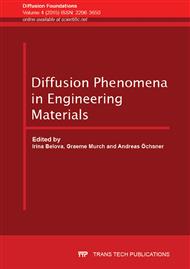[1]
G.G. Hammes, Physical chemistry for the biological sciences, Wiley-Interscience, Hoboken, New Jersey 2007, Chapter 3.
Google Scholar
[2]
J. -C. Olsen, K. E. Griffiths, J. F. Stoddart, A Short History of the Mechanical Bond, in From Non-Covalent Assemblies to Molecular Machines, J. -P. Sauvage, P. Gaspard (Eds. ), Wiley-VCH: Weinheim, Germany (2011), pp.67-139.
DOI: 10.1002/9783527632817.ch8
Google Scholar
[3]
D.A. Morton-Blake, Molecular dynamics of the transport of ions in a synthetic channel, Diffusion Fundamentals 1 (2014) 77-95.
Google Scholar
[4]
D.A. Morton-Blake, Conan Kumari-Doyle, The motion of an ion in a synthetic molecular ion channel, Computational and Theoretical Chemistry 1008 (2013).
DOI: 10.1016/j.comptc.2012.12.007
Google Scholar
[5]
N. Sakai, S. Matile, Synthetic ion channels, Langmuir 29 (2013).
Google Scholar
[6]
V.E. Carmichel, P. Dutton, T. Fyles, T. James, J. Swan, M. Zojaji, Biomimetic ion transport: A functional model of a unimolecular ion channel, J. Amer. Chem. Soc. 111 (1989) 767-769.
DOI: 10.1021/ja00184a075
Google Scholar
[7]
N. Voyer, M. Robitaille, A novel functional artificial channel, J. Am. Chem. Soc. 117 (1995) 6599-6600.
DOI: 10.1021/ja00129a027
Google Scholar
[8]
W. Kabsch, C. Sander, Dictionary of protein secondary structure: pattern recognition of hydrogen-bonded and geometrical features, Biopolymers. 22 (1983) 2577-2637.
DOI: 10.1002/bip.360221211
Google Scholar
[9]
W. Smith, T.R. Forester, DL_POLY_2. 0: a general-purpose parallel molecular dynamics simulation package, J. Molec. Graphics 14 (1996) 136.
DOI: 10.1016/s0263-7855(96)00043-4
Google Scholar
[10]
Gaussian 03, Revision E. 01, M. J. Frisch, G. W. Trucks, H. B. Schlegel, G. E. Scuseria, M. A. Robb, J. R. Cheeseman, J. A. Montgomery, Jr., T. Vreven, K. N. Kudin, J. C. Burant, J. M. Millam, S. S. Iyengar, J. Tomasi, V. Barone, B. Mennucci, M. Cossi, G. Scalmani, N. Rega, G. A. Petersson, H. Nakatsuji, M. Hada, M. Ehara, K. Toyota, R. Fukuda, J. Hasegawa, M. Ishida, T. Nakajima, Y. Honda, O. Kitao, H. Nakai, M. Klene, X. Li, J. E. Knox, H. P. Hratchian, J. B. Cross, V. Bakken, C. Adamo, J. Jaramillo, R. Gomperts, R. E. Stratmann, O. Yazyev, A. J. Austin, R. Cammi, C. Pomelli, J. W. Ochterski, P. Y. Ayala, K. Morokuma, G. A. Voth, P. Salvador, J. J. Dannenberg, V. G. Zakrzewski, S. Dapprich, A. D. Daniels, M. C. Strain, O. Farkas, D. K. Malick, A. D. Rabuck, K. Raghavachari, J. B. Foresman, J. V. Ortiz, Q. Cui, A. G. Baboul, S. Clifford, J. Cioslowski, B. B. Stefanov, G. Liu, A. Liashenko, P. Piskorz, I. Komaromi, R. L. Martin, D. J. Fox, T. Keith, M. A. Al-Laham, C. Y. Peng, A. Nanayakkara, M. Challacombe, P. M. W. Gill, B. Johnson, W. Chen, M. W. Wong, C. Gonzalez, J. A. Pople, Gaussian, Inc., Wallingford CT, (2004).
Google Scholar
[11]
J. Åqvist, Ion-water interaction potentials derived from free energy perturbation simulations, J. Phys. Chem. 94 (1990) 8021-8024.
DOI: 10.1021/j100384a009
Google Scholar
[12]
S.H. Lee, J.C. Rasaiah, Molecular dynamics simulation of ion mobility. 2. Alkali metal halide ions using the SPC/E model for water at 25°C, J. Chem. Phys. 100 (1996) 1420-1425.
DOI: 10.1021/jp953050c
Google Scholar
[13]
S. L. Mayo, B. D. Olafson, W.A. Goddard III, DREIDING: A generic force field for molecular simulations, J. Phys. Chem. 94 (1990) 8897-8909.
DOI: 10.1021/j100389a010
Google Scholar
[14]
H. J. C. Berendsen, J. R. Grigera, T. P. Straatsma, The missing term in effective pair potentials, J. Phys. Chem. 91 (1987) 6269-6271.
DOI: 10.1021/j100308a038
Google Scholar
[15]
W.T. Coffey, Yu.P. Kalmykov, J.T. Waldron, The Langevin Equation: with Applications to Stochastic Problems in Physics, Chemistry and Electrical Engineering, second edition, World Scientific Singapore, 2004, Chapter 1.
DOI: 10.1142/5343
Google Scholar
[16]
A.R. Tiller, Dielectric relaxation in polymers by molecular dynamics simulation, Macromolecules 25 (1992) 4605-4611.
DOI: 10.1021/ma00044a022
Google Scholar
[17]
E. Samson, J. Marchand K.A. Snyder, Calculation of ionic diffusion coefficients on the basis of migration test results, Materials and Structures 36 (2003) 156-165.
DOI: 10.1007/bf02479554
Google Scholar
[18]
P. Atkins, J. de Paula, Physical Chemistry, eighth edition, Oxford University Press, Oxford 2006 , Chapter 21.
Google Scholar
[19]
A. Faracone, L. Liu, C. -Y. Mou, P.C. Shih, J.R.D. Copley, S.H. Chen, Translational and rotational dynamics of water in mesoporous silica materials, J. Chem. Phys. 119 (2003) 3963-3971.
DOI: 10.1063/1.1584653
Google Scholar
[20]
R. A. Fouracre, M. J. Given, B. H. Crichton, The effect of alternating fields on ion migration in solid dielectrics, J. Phys. C: Solid State Phys. 19 (1986) 1949-(1958).
DOI: 10.1088/0022-3719/19/12/009
Google Scholar
[21]
L. Gammaitoni, P. Hänggi, P. Jung, F. Marchesoni, Stochastic resonance, Rev. Mod. Phys. 70 (1998) 224-287.
DOI: 10.1103/revmodphys.70.223
Google Scholar


